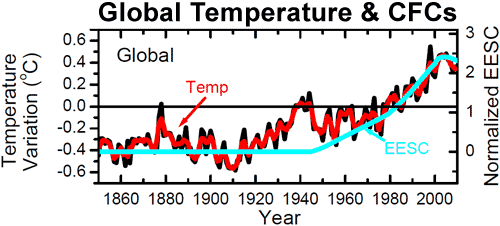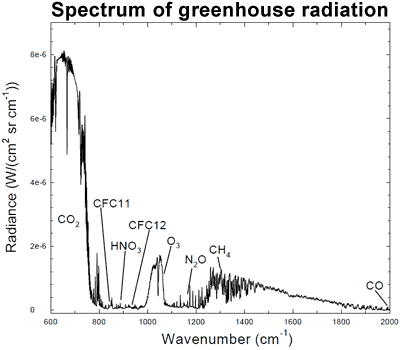Could CFCs be causing global warming?
Posted on 27 December 2009 by John Cook
A new paper Cosmic-ray-driven electron-induced reactions of halogenated molecules adsorbed on ice surfaces: Implications for atmospheric ozone depletion (Lu 2009) examines the link between CFCs, cosmic rays and global warming. The bulk of the paper concentrates on the link between cosmic rays and depletion of ozone in the Arctic and Antarctic regions. This is interesting work that warrants a closer look (perhaps the subject of a future post) and the role of cosmic rays on climate are address elsewhere. However, the strongest statement is found towards the end of the paper, stating that "these data strongly indicate that global temperature has been dominantly controlled by the level of CFCs, modulated by the cosmic ray-driven ozone depletion over the past century." Lu is saying that the increased greenhouse effect from CFCs is the main contributor to global warming in recent decades. What is this based on?
The IPCC AR4 estimate that the radiative forcing from CFCs is 0.33 W/m². This is about 13% of the total radiative forcing from increased greenhouse gases (with carbon dioxide being the main contributor). However, Lu dismisses this value, arguing that CFC radiative forcing is calculated from climate models and not from direct observations. To examine the potential relationship between temperature and CFCs, Lu compares global temperature to Equivalent Effective Stratospheric Chlorine (EESC), a measure of atmospheric CFCs. There is no EESC data before 1970 so the data is extrapolated backwards assuming an identical growth rate until EESC levels hit 0 in the 1940s.

Figure 1: Global surface temperature (HadCRUT3). Solid black line is original observed data. Solid red line is 3-point smoothed average of global temperature. Blue is Equivalent effective stratospheric chlorine (EESC), a measure of atmospheric CFCs (Lu 2009).
Lu argues that the correlation between global temperature and CFCs is evidence that CFCs have been the dominant driver of climate over the past century. While there were large short-term fluctuations between 1850 to 1950, global temperature did not show significant overall rise over this period when CO2 was rising. Temperatures started increasing around 1950, when EESC levels started to become significant. Finally, EESC peaked around 2000 and has fallen in the last few years while the HadCRUT3 temperature record shows cooling in the same period. Based on this correlation, Lu concludes that "these data strongly indicate that global temperature has been dominantly controlled by the level of CFCs... over the past century".
There are several problems with this analysis. The notion that global cooling has been occuring over the last few years is not borne out when one peruses the full range of empirical data. Lu uses HadCRUT data which does not cover the entire globe - the regions where most warming has occured are excluded from the HadCRUT record. Consequently, HadCRUT underestimates recent warming. When one considers the energy building in the entire climate system (especially the oceans where most heat resides), we see that the planet is still accumulating heat through to 2009 (Murphy 2009, von Schuckmann 2009). In recent years while the radiative forcing from CFCs was falling, the planet has still been in positive energy balance.
The physics of how CFCs might impose such a strong radiative forcing are not addressed. Lu mentions that the radiative forcing from CFCs haven't been directly measured, then moves onto statistical correlations. In fact, the greenhouse effect from CFCs have been quantified from surface observations of the infrared radiation spectrum (Evans 2006). The observed results are broadly consistent with model predictions of greenhouse forcing (although observations show slightly higher forcing than model results). The proportion of CFC forcing compared to total greenhouse forcing is still around 14%, a close match to the IPCC estimate of 13%.

Figure 2: Spectrum of the greenhouse radiation measured at the surface. Greenhouse effect from water vapor is filtered out, showing the contributions of other greenhouse gases (Evans 2006).
So we see that CFCs play only a small part in driving global temperatures. Unfortunately, this means that the recent drop in CFC levels will only have a small impact on global temperatures (if only it could be that easy). Of more concern is the increasing radiative forcing from CO2. The infrared spectrum analysis in Evans 2006 measures the extra heat trapped by rising carbon dioxide, finding a CO2 radiative forcing of 2.1 W/m² (again slightly higher than model predictions). This begs the question to those that argue that CFC (or any other mechanism) is meant to be causing global warming. If so, what's happening to all the heat trapped by CO2?
Thanks to David Brown who initially informed me of Lu 2009. Thanks also to David and John Cross for their support in writing this post.































 Arguments
Arguments























 0
0  0
0







Comments